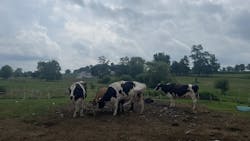EPA announces $14.3M for Pennsylvania through Chesapeake Bay Program
During a visit to a Lancaster County dairy farm, EPA Mid-Atlantic Regional Administrator Adam Ortiz and U.S. Senator Bob Casey joined Pennsylvania environmental leaders, Chesapeake Bay partners, and local farmers to announce $14.3 million in grants directed to Pennsylvania through EPA’s Chesapeake Bay Program.
Using funding provided by the bipartisan Infrastructure Investment and Jobs Act (IIJA), the Most Effective Basins program will receive $23 million this year, a $15 million increase from its $8 million annual allocation. 60% of this year’s funding will go directly to Pennsylvania to connect farmers with the financial resources they need to implement conservation practices that benefit farms, local streams, and the Chesapeake Bay.
The Most Effective Basins grant program provides funds to states in river basins throughout the Chesapeake Bay watershed with excess nitrogen loads. The funds are used to install best practices such as forest buffers, manure storage, and fencing to reduce agricultural runoff from entering nearby streams.
“The infrastructure law is not only fixing our roads and bridges; it’s providing farmers with the support they need to protect and restore the Chesapeake Bay,” said Senator Casey. “It’s a win-win: when we improve conservation practices, our farmers improve their bottom line.”
During the event, officials also highlighted new means to deliver funds to grantees more efficiently. EPA is working with the Pennsylvania Department of Environmental Protection to direct at least $3 million of the Most Effective Basins funding to a block grant that will deliver conservation funding to farmers more quickly. An additional $4 million will go to the state Department of Agriculture and State Conservation Commission to support the work of the Conservation Districts.
“Pennsylvania is proof of the enormous value of partnership in improving the health of the Chesapeake Bay watershed,” said Pennsylvania Department of Environmental Protection Secretary Rich Negrin. “DEP has long valued our partnerships with EPA Region 3, USDA-NRCS, the Chesapeake Bay Program, and our jurisdictional partners. In the past five years, we've taken this teamwork to exciting new levels. Our funding of conservation districts and local organizations helps provide the agricultural outreach, education, planning, and technical assistance needed to keep building momentum from the ground up to ensure clean water for Pennsylvania’s farmers and communities.”


